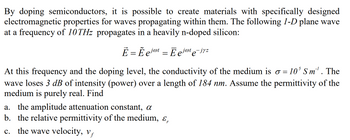
Introductory Circuit Analysis (13th Edition)
13th Edition
ISBN: 9780133923605
Author: Robert L. Boylestad
Publisher: PEARSON
expand_more
expand_more
format_list_bulleted
Question

Transcribed Image Text:By doping semiconductors, it is possible to create materials with specifically designed
electromagnetic properties for waves propagating within them. The following 1-D plane wave
at a frequency of 10THz propagates in a heavily n-doped silicon:
Ē = Ẽ ejot = Ēejat e¯jyz
At this frequency and the doping level, the conductivity of the medium is o=105 Sm'. The
wave loses 3 dB of intensity (power) over a length of 184 nm. Assume the permittivity of the
medium is purely real. Find
a. the amplitude attenuation constant, a
b. the relative permittivity of the medium, &,
c. the wave velocity, v
Expert Solution
This question has been solved!
Explore an expertly crafted, step-by-step solution for a thorough understanding of key concepts.
Step by stepSolved in 2 steps

Knowledge Booster
Learn more about
Need a deep-dive on the concept behind this application? Look no further. Learn more about this topic, electrical-engineering and related others by exploring similar questions and additional content below.Similar questions
- Give the peak value, angluar velocity (w), frequency (f), and period (T) for ac wave i=4.0sin 120πtarrow_forwardImagine a two-dimensional system in which a sinusoidal waveform is excited at the exact center of a circular plate. The standing wave pattern is established when the excited wave two-dimensionalwaveforms for a stable equilibrium pattern of constructive and destructive interference with the reflected waves from the edge of the circular plate. Draw what you expect the standing wave patterns to look like in this two-dimensional system for increasing resonant harmonics, n. Explain what characteristics of the oscillating plate affect the value of those resonancefrequencies, and what geometric properties of the plate affect the patterns.arrow_forward8. Let us consider the following circuit: Vin R Vin (a) Find an expression for Vout in terms of Vin, d, R, C, and R. (b) For this part, assume R = R and R*C = 1s. Also take Vin to be a triangle wave of amplitude 1V and period 1s. Draw a plot of Vin and Vout- (The triangle wave should start from zero and rise linearly to its maximum of 1V, which it reaches at t = 0.5s; it should then decrease linearly back to OV, which it reaches at t = 1s.) (c) Consider changing the circuit to: R R Vi-W Cg RE www How would this change your results to (a) and (b)? (Hint: what are in and i, for the op-amp? This isn't hard!) (d) Consider the following circuit: + Find Vout as a function of V₁, R, RF, C, and RE RE ww Rg Ce Vout RE www Vout -Voutarrow_forward
Recommended textbooks for you
 Introductory Circuit Analysis (13th Edition)Electrical EngineeringISBN:9780133923605Author:Robert L. BoylestadPublisher:PEARSON
Introductory Circuit Analysis (13th Edition)Electrical EngineeringISBN:9780133923605Author:Robert L. BoylestadPublisher:PEARSON Delmar's Standard Textbook Of ElectricityElectrical EngineeringISBN:9781337900348Author:Stephen L. HermanPublisher:Cengage Learning
Delmar's Standard Textbook Of ElectricityElectrical EngineeringISBN:9781337900348Author:Stephen L. HermanPublisher:Cengage Learning Programmable Logic ControllersElectrical EngineeringISBN:9780073373843Author:Frank D. PetruzellaPublisher:McGraw-Hill Education
Programmable Logic ControllersElectrical EngineeringISBN:9780073373843Author:Frank D. PetruzellaPublisher:McGraw-Hill Education Fundamentals of Electric CircuitsElectrical EngineeringISBN:9780078028229Author:Charles K Alexander, Matthew SadikuPublisher:McGraw-Hill Education
Fundamentals of Electric CircuitsElectrical EngineeringISBN:9780078028229Author:Charles K Alexander, Matthew SadikuPublisher:McGraw-Hill Education Electric Circuits. (11th Edition)Electrical EngineeringISBN:9780134746968Author:James W. Nilsson, Susan RiedelPublisher:PEARSON
Electric Circuits. (11th Edition)Electrical EngineeringISBN:9780134746968Author:James W. Nilsson, Susan RiedelPublisher:PEARSON Engineering ElectromagneticsElectrical EngineeringISBN:9780078028151Author:Hayt, William H. (william Hart), Jr, BUCK, John A.Publisher:Mcgraw-hill Education,
Engineering ElectromagneticsElectrical EngineeringISBN:9780078028151Author:Hayt, William H. (william Hart), Jr, BUCK, John A.Publisher:Mcgraw-hill Education,

Introductory Circuit Analysis (13th Edition)
Electrical Engineering
ISBN:9780133923605
Author:Robert L. Boylestad
Publisher:PEARSON

Delmar's Standard Textbook Of Electricity
Electrical Engineering
ISBN:9781337900348
Author:Stephen L. Herman
Publisher:Cengage Learning

Programmable Logic Controllers
Electrical Engineering
ISBN:9780073373843
Author:Frank D. Petruzella
Publisher:McGraw-Hill Education

Fundamentals of Electric Circuits
Electrical Engineering
ISBN:9780078028229
Author:Charles K Alexander, Matthew Sadiku
Publisher:McGraw-Hill Education

Electric Circuits. (11th Edition)
Electrical Engineering
ISBN:9780134746968
Author:James W. Nilsson, Susan Riedel
Publisher:PEARSON

Engineering Electromagnetics
Electrical Engineering
ISBN:9780078028151
Author:Hayt, William H. (william Hart), Jr, BUCK, John A.
Publisher:Mcgraw-hill Education,